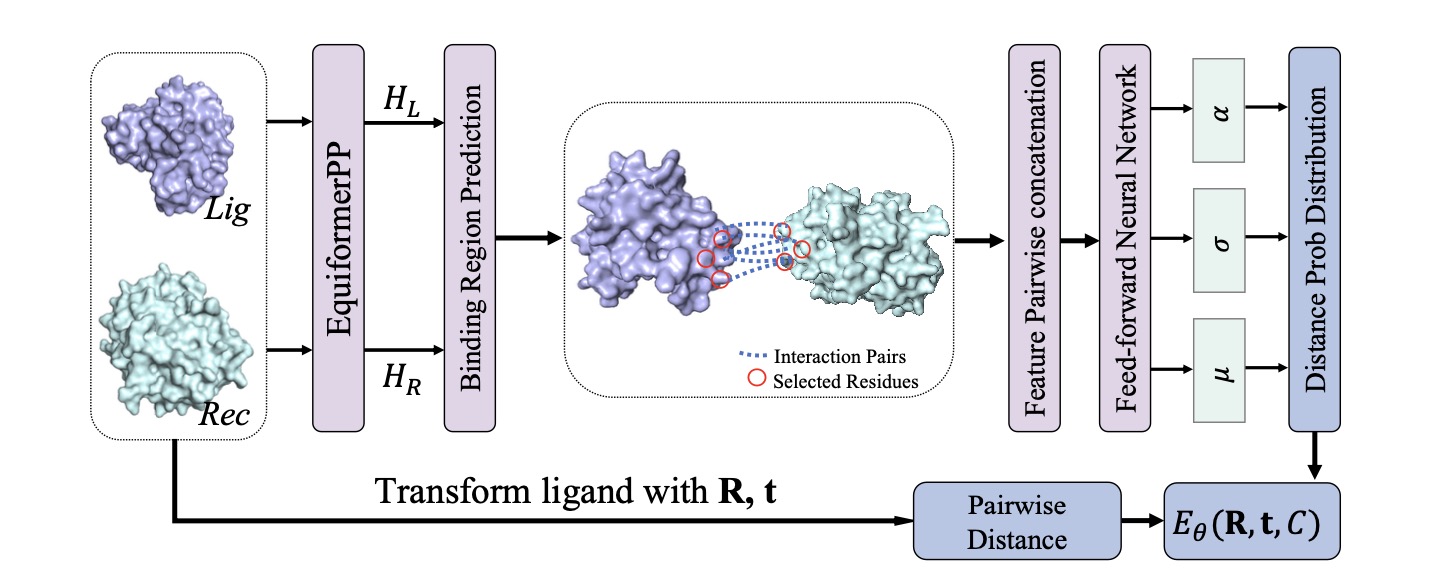Official implementation for the paper "EBMDOCK: NEURAL PROBABILISTIC PROTEIN-PROTEIN DOCKING VIA A DIFFERENTIABLE ENERGY-BASED MODEL" (ICLR 2024). https://openreview.net/pdf?id=qg2boc2AwU
This work was developed and tested under pytorch 1.12.1 with CUDA 11.6. Please install main dependencies as follows:
conda create -n dock python=3.9
conda activate dock
conda install pytorch==1.12.1 torchvision==0.13.1 torchaudio==0.12.1 cudatoolkit=11.6 -c pytorch -c conda-forge
conda install pyg -c pyg
pip install pyg_lib torch_scatter torch_sparse torch_cluster torch_spline_conv torch_geometric -f https://data.pyg.org/whl/torch-1.12.1+cu116.html
pip install pandas biopandas dill biopandas e3nn biopython==1.80 horovod[pytorch]==0.27.0
pip install networkx==2.6.3 dgl==1.1.3 dglgo==0.0.2 dgllife==0.3.2
We have provided raw data in data/DB5/structures.
We follow ''trimodock: Rigid protein docking via cross-modal representation learning and spectral algorithm'' and select 68 antibody-antigen samples from the Protein Data Bank which were released after October 2022.
We have provided the raw data in data/antibody-antigen.
We use DIPS-Het to train our model. Input data to this dataset generation pipeline can be downloaded from the RCSB database, further steps please refer to data/DIPS-Het
- You can train an energy model by running:
python train.py -ebm_train -n_gaussians 6 -dataset dipshet -data_path ./data/DIPS-Het
Use -ebm_train is a little bit time consuming, you can also use -ll_train instead (which directly maximize the log_likelihood of distances).
- You can train an interface prediction model by running:
python train.py -cp -dataset dipshet -data_path ./data/DIPS-Het
- You can also train 1,2 at the same time by running:
python train.py -cp -dataset dipshet -data_path ./data/DIPS-Het -ebm_train -n_gaussians 6
- We have provided the pretrained model in
checkpoints/, you can evaluate a trained model by running:
python evaluate.py -dataset db5 -data_path ./data/DB5 -intersection_loss -known_interface
Here -known_interface means when we have a rough knowledge of the interaction interface. You can also use the trained model to predict the interaction interface (just remove -knwon_interface).
- You can predict the docking pose of any two proteins by running:
python inference.py -receptor_file_path [your receptor file path] -ligand_file_path [your ligand file path] -output_ligand_path [the output ligand file path]
This will generate the predicted ligand pose and the result pdb will be saved in -output_ligand_path.
If you use our code or method in your work, please consider citing the following:
@inproceedings{wu2023neural,
title={EBMDock: Neural Probabilistic Protein-Protein Docking via a Differentiable Energy Model},
author={Wu, Huaijin and Liu, Wei and Bian, Yatao and Wu, Jiaxiang and Yang, Nianzu and Yan, Junchi},
booktitle={The Twelfth International Conference on Learning Representations},
year={2024}
}
Please direct any questions to Huaijin Wu (whj1201@sjtu.edu.cn)
We appreciate the following works for their valuable code and data:
https://github.com/octavian-ganea/equidock_public
